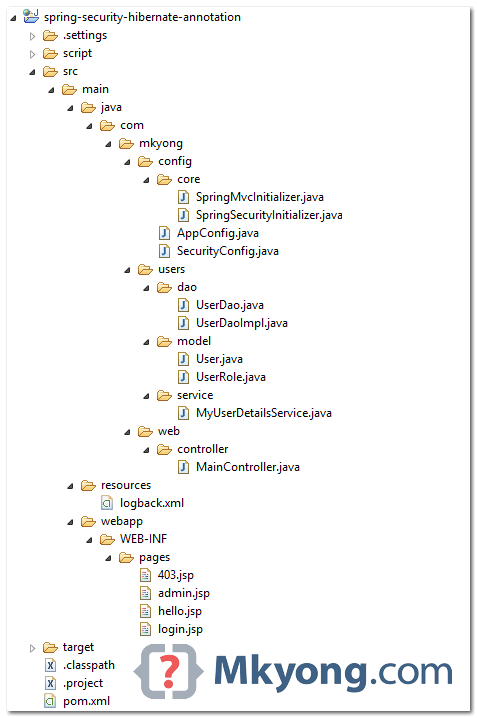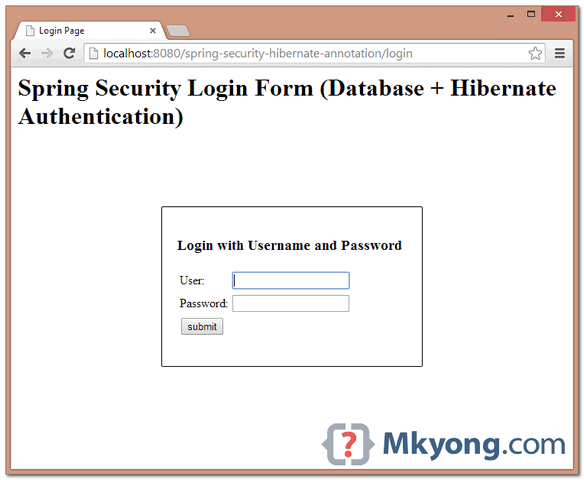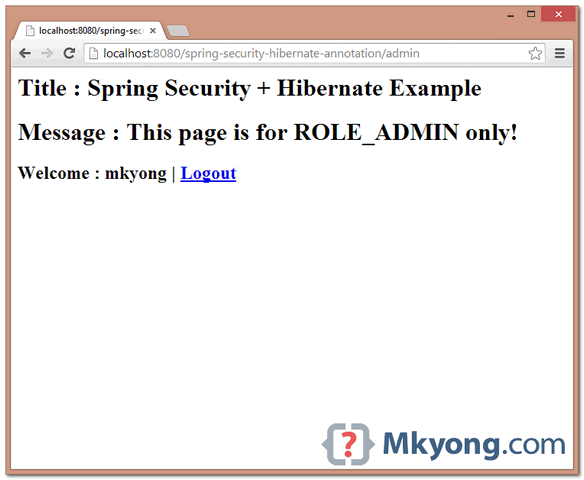In this tutorial, previous Spring Security + Hibernate4 XML example will be reused, and convert it to a annotation-based example.
Technologies used :
- Spring 3.2.8.RELEASE
- Spring Security 3.2.3.RELEASE
- Hibernate 4.2.11.Final
- MySQL Server 5.6
- Tomcat 7 (Servlet 3.x container)
Quick Note :
- Create a session factory with LocalSessionFactoryBuilder
- Inject session factory into a UserDao
- Integrate UserDao into a custom UserDetailsService, to load users from the database.
1. Project Directory
A final project directory structure.
2. User Model + Mapping File
Model classes and its’ annotation-based mapping file.
User.java
package com.mkyong.users.model;
import java.util.HashSet;
import java.util.Set;
import javax.persistence.Column;
import javax.persistence.Entity;
import javax.persistence.FetchType;
import javax.persistence.Id;
import javax.persistence.OneToMany;
import javax.persistence.Table;
@Entity
@Table(name = "users", catalog = "test")
public class User {
private String username;
private String password;
private boolean enabled;
private Set<UserRole> userRole = new HashSet<UserRole>(0);
public User() {
}
public User(String username, String password, boolean enabled) {
this.username = username;
this.password = password;
this.enabled = enabled;
}
public User(String username, String password,
boolean enabled, Set<UserRole> userRole) {
this.username = username;
this.password = password;
this.enabled = enabled;
this.userRole = userRole;
}
@Id
@Column(name = "username", unique = true,
nullable = false, length = 45)
public String getUsername() {
return this.username;
}
public void setUsername(String username) {
this.username = username;
}
@Column(name = "password",
nullable = false, length = 60)
public String getPassword() {
return this.password;
}
public void setPassword(String password) {
this.password = password;
}
@Column(name = "enabled", nullable = false)
public boolean isEnabled() {
return this.enabled;
}
public void setEnabled(boolean enabled) {
this.enabled = enabled;
}
@OneToMany(fetch = FetchType.LAZY, mappedBy = "user")
public Set<UserRole> getUserRole() {
return this.userRole;
}
public void setUserRole(Set<UserRole> userRole) {
this.userRole = userRole;
}
}UserRole.java
package com.mkyong.users.model;
import static javax.persistence.GenerationType.IDENTITY;
import javax.persistence.Column;
import javax.persistence.Entity;
import javax.persistence.FetchType;
import javax.persistence.GeneratedValue;
import javax.persistence.Id;
import javax.persistence.JoinColumn;
import javax.persistence.ManyToOne;
import javax.persistence.Table;
import javax.persistence.UniqueConstraint;
@Entity
@Table(name = "user_roles", catalog = "test",
uniqueConstraints = @UniqueConstraint(
columnNames = { "role", "username" }))
public class UserRole{
private Integer userRoleId;
private User user;
private String role;
public UserRole() {
}
public UserRole(User user, String role) {
this.user = user;
this.role = role;
}
@Id
@GeneratedValue(strategy = IDENTITY)
@Column(name = "user_role_id",
unique = true, nullable = false)
public Integer getUserRoleId() {
return this.userRoleId;
}
public void setUserRoleId(Integer userRoleId) {
this.userRoleId = userRoleId;
}
@ManyToOne(fetch = FetchType.LAZY)
@JoinColumn(name = "username", nullable = false)
public User getUser() {
return this.user;
}
public void setUser(User user) {
this.user = user;
}
@Column(name = "role", nullable = false, length = 45)
public String getRole() {
return this.role;
}
public void setRole(String role) {
this.role = role;
}
}3. DAO Class
DAO classes, to load data from the database, via Hibernate.
UserDao.java
package com.mkyong.users.dao;
import com.mkyong.users.model.User;
public interface UserDao {
User findByUserName(String username);
}UserDaoImpl.java
package com.mkyong.users.dao;
import java.util.ArrayList;
import java.util.List;
import org.hibernate.SessionFactory;
import org.springframework.beans.factory.annotation.Autowired;
import org.springframework.stereotype.Repository;
import com.mkyong.users.model.User;
@Repository
public class UserDaoImpl implements UserDao {
@Autowired
private SessionFactory sessionFactory;
@SuppressWarnings("unchecked")
public User findByUserName(String username) {
List<User> users = new ArrayList<User>();
users = sessionFactory.getCurrentSession()
.createQuery("from User where username=?")
.setParameter(0, username)
.list();
if (users.size() > 0) {
return users.get(0);
} else {
return null;
}
}
}4. UserDetailsService
Uses @Transactional to declare a transactional method.
MyUserDetailsService.java
package com.mkyong.users.service;
import java.util.ArrayList;
import java.util.HashSet;
import java.util.List;
import java.util.Set;
import org.springframework.beans.factory.annotation.Autowired;
import org.springframework.security.core.GrantedAuthority;
import org.springframework.security.core.authority.SimpleGrantedAuthority;
import org.springframework.security.core.userdetails.User;
import org.springframework.security.core.userdetails.UserDetails;
import org.springframework.security.core.userdetails.UserDetailsService;
import org.springframework.security.core.userdetails.UsernameNotFoundException;
import org.springframework.stereotype.Service;
import org.springframework.transaction.annotation.Transactional;
import com.mkyong.users.dao.UserDao;
import com.mkyong.users.model.UserRole;
@Service("userDetailsService")
public class MyUserDetailsService implements UserDetailsService {
//get user from the database, via Hibernate
@Autowired
private UserDao userDao;
@Transactional(readOnly=true)
@Override
public UserDetails loadUserByUsername(final String username)
throws UsernameNotFoundException {
com.mkyong.users.model.User user = userDao.findByUserName(username);
List<GrantedAuthority> authorities =
buildUserAuthority(user.getUserRole());
return buildUserForAuthentication(user, authorities);
}
// Converts com.mkyong.users.model.User user to
// org.springframework.security.core.userdetails.User
private User buildUserForAuthentication(com.mkyong.users.model.User user,
List<GrantedAuthority> authorities) {
return new User(user.getUsername(), user.getPassword(),
user.isEnabled(), true, true, true, authorities);
}
private List<GrantedAuthority> buildUserAuthority(Set<UserRole> userRoles) {
Set<GrantedAuthority> setAuths = new HashSet<GrantedAuthority>();
// Build user's authorities
for (UserRole userRole : userRoles) {
setAuths.add(new SimpleGrantedAuthority(userRole.getRole()));
}
List<GrantedAuthority> Result = new ArrayList<GrantedAuthority>(setAuths);
return Result;
}
}5. Spring Security Annotation
Declares and binds everything with annotations, read the comments, it should be self-explanatory.
SecurityConfig.java
package com.mkyong.config;
import org.springframework.beans.factory.annotation.Autowired;
import org.springframework.beans.factory.annotation.Qualifier;
import org.springframework.context.annotation.Bean;
import org.springframework.context.annotation.Configuration;
import org.springframework.security.config.annotation.authentication.builders.AuthenticationManagerBuilder;
import org.springframework.security.config.annotation.web.builders.HttpSecurity;
import org.springframework.security.config.annotation.web.configuration.EnableWebSecurity;
import org.springframework.security.config.annotation.web.configuration.WebSecurityConfigurerAdapter;
import org.springframework.security.core.userdetails.UserDetailsService;
import org.springframework.security.crypto.bcrypt.BCryptPasswordEncoder;
import org.springframework.security.crypto.password.PasswordEncoder;
@Configuration
@EnableWebSecurity
public class SecurityConfig extends WebSecurityConfigurerAdapter {
@Autowired
@Qualifier("userDetailsService")
UserDetailsService userDetailsService;
@Autowired
public void configureGlobal(AuthenticationManagerBuilder auth) throws Exception {
auth.userDetailsService(userDetailsService).passwordEncoder(passwordEncoder());
}
@Override
protected void configure(HttpSecurity http) throws Exception {
http.authorizeRequests().antMatchers("/admin/**")
.access("hasRole('ROLE_ADMIN')").and().formLogin()
.loginPage("/login").failureUrl("/login?error")
.usernameParameter("username")
.passwordParameter("password")
.and().logout().logoutSuccessUrl("/login?logout")
.and().csrf()
.and().exceptionHandling().accessDeniedPage("/403");
}
@Bean
public PasswordEncoder passwordEncoder(){
PasswordEncoder encoder = new BCryptPasswordEncoder();
return encoder;
}
}Uses LocalSessionFactoryBuilder to create a session factory.
AppConfig.java
package com.mkyong.config;
import java.util.Properties;
import org.apache.commons.dbcp.BasicDataSource;
import org.hibernate.SessionFactory;
import org.springframework.context.annotation.Bean;
import org.springframework.context.annotation.ComponentScan;
import org.springframework.context.annotation.Configuration;
import org.springframework.context.annotation.Import;
import org.springframework.orm.hibernate4.HibernateTransactionManager;
import org.springframework.orm.hibernate4.LocalSessionFactoryBuilder;
import org.springframework.transaction.annotation.EnableTransactionManagement;
import org.springframework.web.servlet.config.annotation.EnableWebMvc;
import org.springframework.web.servlet.view.InternalResourceViewResolver;
import org.springframework.web.servlet.view.JstlView;
@EnableWebMvc
@Configuration
@ComponentScan({ "com.mkyong.*" })
@EnableTransactionManagement
@Import({ SecurityConfig.class })
public class AppConfig {
@Bean
public SessionFactory sessionFactory() {
LocalSessionFactoryBuilder builder =
new LocalSessionFactoryBuilder(dataSource());
builder.scanPackages("com.mkyong.users.model")
.addProperties(getHibernateProperties());
return builder.buildSessionFactory();
}
private Properties getHibernateProperties() {
Properties prop = new Properties();
prop.put("hibernate.format_sql", "true");
prop.put("hibernate.show_sql", "true");
prop.put("hibernate.dialect",
"org.hibernate.dialect.MySQL5Dialect");
return prop;
}
@Bean(name = "dataSource")
public BasicDataSource dataSource() {
BasicDataSource ds = new BasicDataSource();
ds.setDriverClassName("com.mysql.jdbc.Driver");
ds.setUrl("jdbc:mysql://localhost:3306/test");
ds.setUsername("root");
return ds;
}
//Create a transaction manager
@Bean
public HibernateTransactionManager txManager() {
return new HibernateTransactionManager(sessionFactory());
}
@Bean
public InternalResourceViewResolver viewResolver() {
InternalResourceViewResolver viewResolver
= new InternalResourceViewResolver();
viewResolver.setViewClass(JstlView.class);
viewResolver.setPrefix("/WEB-INF/pages/");
viewResolver.setSuffix(".jsp");
return viewResolver;
}
}Done.
6. Project Demo
The following video demo is for the Spring Security database login tutorial. Since this tutorial is generating the same output, so the video demo is reused.

























 908
908

 被折叠的 条评论
为什么被折叠?
被折叠的 条评论
为什么被折叠?








